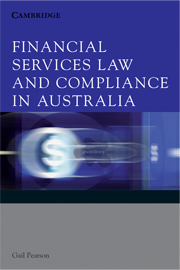Book contents
- Frontmatter
- Contents
- Preface
- List of Abbreviations
- Table of Statutes
- Table of Cases
- 1 The financial citizen and the market
- 2 The regulatory structure
- 3 An overview of financial services reform
- 4 Licensing financial services providers
- 5 The role of disclosure in the distribution of financial products
- 6 Selling financial products and other conduct
- 7 Deposit-taking and payments
- 8 Investment
- 9 Insurance
- 10 Consumer credit
- 11 Superannuation
- 12 Compliance, enforcement and remedies
- Index
- References
2 - The regulatory structure
Published online by Cambridge University Press: 05 June 2012
- Frontmatter
- Contents
- Preface
- List of Abbreviations
- Table of Statutes
- Table of Cases
- 1 The financial citizen and the market
- 2 The regulatory structure
- 3 An overview of financial services reform
- 4 Licensing financial services providers
- 5 The role of disclosure in the distribution of financial products
- 6 Selling financial products and other conduct
- 7 Deposit-taking and payments
- 8 Investment
- 9 Insurance
- 10 Consumer credit
- 11 Superannuation
- 12 Compliance, enforcement and remedies
- Index
- References
Summary
Regulating while being regulated ourselves.
The philosophy and approach to regulation
The Australian regulatory model for financial services derives from the Inquiry into the financial system, which was undertaken in the late 1990s. The resulting Wallis Report led to extensive changes to the legal framework. The Report outlined three broad purposes for regulating markets: to ensure these markets operate efficiently and effectively; to prescribe particular standards or qualities of service and promote financial safety; and to achieve certain social objectives. The Report also recognised the key principles of regulation as competitive neutrality, cost effectiveness, transparency, flexibility and accountability. According to the Wallis Report, the basic reason behind the need for regulation is market failure arising from ‘systemic instability’ and ‘information asymmetry’. Systemic instability arises where ‘certain financial promises have an inherent capacity to transmit instability to the real economy, inducing undesired effects on output, employment and price inflation’. Information asymmetry leads to the inability to assess risk and creditworthiness. The Report acknowledged the limits to information disclosure because ‘consumers lack (and cannot efficiently obtain) the knowledge, experience or judgment required to make informed decisions’ about some products, thus ‘further disclosure, no matter how high quality or comprehensive, cannot overcome market failure’. For this reason, the Wallis Report acknowledged the role of third parties in supplying information and opinions.
- Type
- Chapter
- Information
- Financial Services Law and Compliance in Australia , pp. 20 - 68Publisher: Cambridge University PressPrint publication year: 2009
References
- 1
- Cited by



